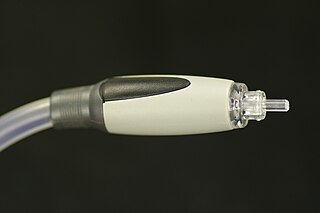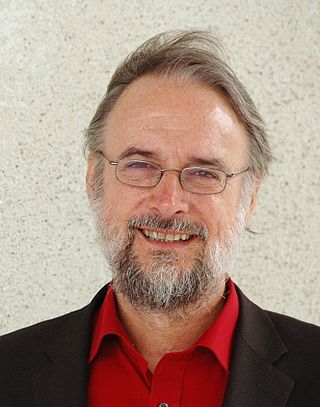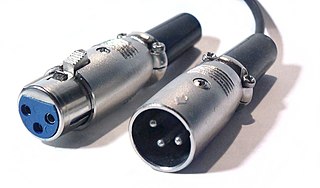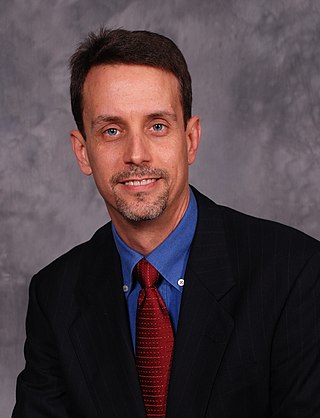
Digital audio is a representation of sound recorded in, or converted into, digital form. In digital audio, the sound wave of the audio signal is typically encoded as numerical samples in a continuous sequence. For example, in CD audio, samples are taken 44,100 times per second, each with 16-bit sample depth. Digital audio is also the name for the entire technology of sound recording and reproduction using audio signals that have been encoded in digital form. Following significant advances in digital audio technology during the 1970s and 1980s, it gradually replaced analog audio technology in many areas of audio engineering, record production and telecommunications in the 1990s and 2000s.

S/PDIF is a type of digital audio interface used in consumer audio equipment to output audio over relatively short distances. The signal is transmitted over either a coaxial cable or a fiber-optic cable with TOSLINK connectors. S/PDIF interconnects components in home theaters and other digital high-fidelity systems.
The Society of Motion Picture and Television Engineers (SMPTE), founded in 1916 as the Society of Motion Picture Engineers or SMPE, is a global professional association of engineers, technologists, and executives working in the media and entertainment industry. As an internationally recognized standards organization, SMPTE has published more than 800 technical standards and related documents for broadcast, filmmaking, digital cinema, audio recording, information technology (IT), and medical imaging.
AES3 is a standard for the exchange of digital audio signals between professional audio devices. An AES3 signal can carry two channels of pulse-code-modulated digital audio over several transmission media including balanced lines, or ounbalanced lines, and optical fiber.

Karlheinz Brandenburg is a German electrical engineer and mathematician. Together with Ernst Eberlein, Heinz Gerhäuser, Bernhard Grill, Jürgen Herre and Harald Popp, he developed the widespread MP3 method for audio data compression. He is also known for his elementary work in the field of audio coding, the perception measurement, the wave field synthesis and psychoacoustics. Brandenburg has received numerous national and international research awards, prizes and honors for his work. Since 2000 he has been a professor of electronic media technology at the Technical University Ilmenau. Brandenburg was significantly involved in the founding of the Fraunhofer Institute for Digital Media Technology (IDMT) and currently serves as its director.

The XLR connector is a type of electrical connector primarily used in professional audio, video, and stage lighting equipment. XLR connectors are cylindrical in design, with three to seven connector pins, and are often employed for analog balanced audio interconnections, AES3 digital audio, portable intercom, DMX512 lighting control, and for low-voltage power supply. XLR connectors are included to the international standard for dimensions, IEC 61076-2-103. The XLR connector is superficially similar to the smaller DIN connector, with which it is physically incompatible.
AES47 is a standard which describes a method for transporting AES3 professional digital audio streams over Asynchronous Transfer Mode (ATM) networks.

The Acoustical Society of America (ASA) is an international scientific society founded in 1929 dedicated to generating, disseminating and promoting the knowledge of acoustics and its practical applications. The Society is primarily a voluntary organization of about 7500 members and attracts the interest, commitment, and service of many professionals.
The AES11 standard published by the Audio Engineering Society provides a systematic approach to the synchronization of digital audio signals. AES11 recommends using an AES3 signal to distribute audio clocks within a facility. In this application, the connection is referred to as a Digital Audio Reference Signal (DARS).
AES52 is a standard first published by the Audio Engineering Society in March 2006 that specifies the insertion of unique identifiers into the AES3 digital audio transport structure.
In audio and broadcast engineering, Audio over Ethernet is the use of an Ethernet-based network to distribute real-time digital audio. AoE replaces bulky snake cables or audio-specific installed low-voltage wiring with standard network structured cabling in a facility. AoE provides a reliable backbone for any audio application, such as for large-scale sound reinforcement in stadiums, airports and convention centers, multiple studios or stages.
AES51 is a standard first published by the Audio Engineering Society in June 2006 that specifies a method of carrying Asynchronous Transfer Mode (ATM) cells over Ethernet physical structure intended in particular for use with AES47 to carry AES3 digital audio transport structure. The purpose of this is to provide an open standard, Ethernet based approach to the networking of linear (uncompressed) digital audio with extremely high quality-of-service alongside standard Internet Protocol connections.

Multichannel Audio Digital Interface (MADI) standardized as AES10 by the Audio Engineering Society (AES) defines the data format and electrical characteristics of an interface that carries multiple channels of digital audio. The AES first documented the MADI standard in AES10-1991 and updated it in AES10-2003 and AES10-2008. The MADI standard includes a bit-level description and has features in common with the two-channel AES3 interface.
The TEC Awards is an annual program recognizing the achievements of audio professionals. The awards are given to honor technically innovative products as well as companies and individuals who have excelled in sound for television, film, recordings, and concerts. TEC is an acronym for Technical Excellence and Creativity.
D-subminiature connectors are used to carry balanced analog or digital audio on many multichannel professional audio equipment, where the use of XLR connectors is impractical, for example due to space constraints. The most common usage is the DB25, using TASCAM's pinout. To avoid the possibility of bent pins on fixed equipment, the male connector is generally fitted to the cabling and the female connector to the equipment. The DD50 connector usage is described in AES-2id.

An audio engineer helps to produce a recording or a live performance, balancing and adjusting sound sources using equalization, dynamics processing and audio effects, mixing, reproduction, and reinforcement of sound. Audio engineers work on the "technical aspect of recording—the placing of microphones, pre-amp knobs, the setting of levels. The physical recording of any project is done by an engineer... the nuts and bolts."
Gerhard Steinke is a German sound engineer.

Howard Allen Chinn was an American broadcasting engineer who pioneered techniques of analog audio recording as well as radio and television broadcasting practices. Chinn served as chief audio engineer at Columbia Broadcasting System (CBS) beginning in the 1940s, and authored many magazine articles and books on the technical aspects of audio engineering and broadcasting.

Charles Emory Hughes II is an American inventor and audio engineer. He is known for his work on loudspeaker design, and the measurement of professional audio sound systems. Hughes first worked for Peavey Electronics designing loudspeakers and horns where he was granted a patent for the Quadratic-Throat Waveguide horn used in concert loudspeakers. He worked for Altec Lansing for two years as chief engineer for the pro audio division and was granted two more patents. In 2021, Hughes was hired by Biamp as principal engineer.
AES50 is an Audio over Ethernet protocol for multichannel digital audio. It is defined by the AES50-2011 standard for High-resolution multi-channel audio interconnection (HRMAI).









